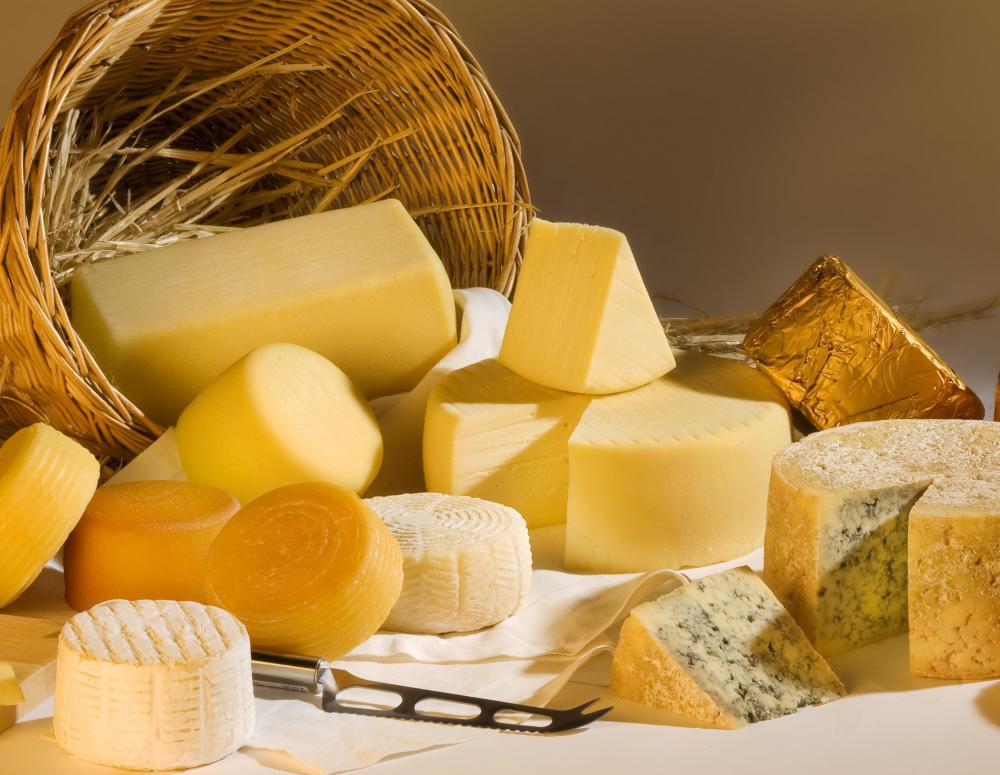At WiseGEEK, we're committed to delivering accurate, trustworthy information. Our expert-authored content is rigorously fact-checked and sourced from credible authorities. Discover how we uphold the highest standards in providing you with reliable knowledge.
What Is Lactose-Free Cheese?
Lactose-free cheese is either cheese treated so it has less lactose in it, or a cheese-like product made from non-dairy sources so it contains no lactose. Lactose is the sugar that appears naturally in milk and most dairy products, and a component of dairy to which a relatively large number of people have a negative reaction. Some brands of cheese advertise their cheese as naturally lactose-free cheese because the process of aging cheese can reduce the levels of lactose to tolerable levels for some people.
People who have a negative reaction to the lactose sugars in dairy are called lactose intolerant, and they usually assume a lactose-reduced or lactose-free diet to improve their symptoms. Different people have different levels of lactose intolerance that can affect how they react to some types of lactose-free cheese. Most dairy-based lactose-free cheeses are not completely lactose-free, but contain such an incredibly small percentage of lactose that it rarely triggers reactions.

Many sharp cheeses are nearly free of lactose. This can help adults with relatively low levels of lactose intolerance, but sharp lactose-free cheese is generally too potent in flavor for children's tastes. For the most part, the sharper the cheese, the less likely it is to have lactose in it.
Lactose-free cheese made from dairy that has been treated to remove the lactose is one option for those on lactose-free diets. Another option is non dairy products, which naturally contain no lactose because they are not made from dairy milk. Non-dairy substitutions for dairy products are as wide in variety as lactose-free products, and also include products made to resemble cheese, milk and yogurt.

Non-dairy milk substitution choices are many, and include almond milk, soy milk, and hemp milk. Each type of non-dairy milk can be treated to make cheese-like substitutes, particularly those resembling soft cheeses like the ones used to make dips and spreads for chips and crackers. Lactose-free cheese that is not made with any dairy is the best option for people who are highly sensitive to the presence of small amounts of lactose. Besides lactose-free cheese, other lactose-free products are many, and include ice cream, milk and baby formula with no lactose or reduced levels of lactose. Though they are not always exactly the same in flavor and texture as their true dairy counterparts, lactose-free products can offer an alternative for people who cannot eat dairy sugar without negative consequences.
AS FEATURED ON:
AS FEATURED ON:














Discussion Comments
My sister had no idea she was sensitive to lactose. She just always said she had a weak stomach. Then she read an article about people who are lactose intolerant, and she figured out this might be her problem. Since then we have both been finding ways to cut back on the amount of dairy we eat.
I had no idea that it is estimated that about 60 percent of adults have problems digesting dairy foods until my sister told me. So you are more likely to have an issue with dairy than you are to have no problem eating these foods. That's why I decided to cut back.
When she was a baby, my daughter starting getting really dry skin behind her knees and then in the bends of her arms. Initially, I was concerned, but I knew this happens with some babies so I wasn't in panic mode. When she started to break out in hives this was another story.
I took her to the doctor, and as soon as the nurse saw her, she asked me about the formula I was using. Then she said she thought my daughter might have a cow protein allergy. We started feeding my daughter soy milk immediately and she never had another issue with the dry skin or the hives. And she never seemed to even notice that her formula had been switched.
The term lactose intolerant sounds too harsh for my condition, but I do limit the amount of dairy products I eat because I sometimes get gas after eating them. Sometimes after I eat dairy products, the grumbling and strange noises coming from my stomach make it sound like there is an alien in there trying to get out.
I have tried some of the fake dairy products that contain no dairy whatsoever, and they all tasted funny to me. As the saying goes, I love dairy it just doesn't love me. However, I am definitely going to try some of the lactose reduced cheeses mentioned here because cheese is one of my favorite dairy products.
Post your comments